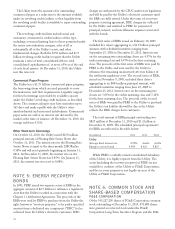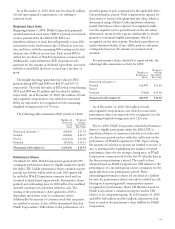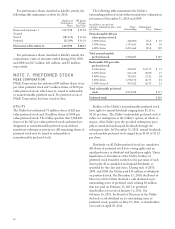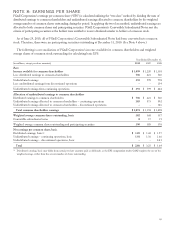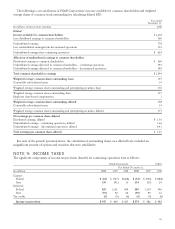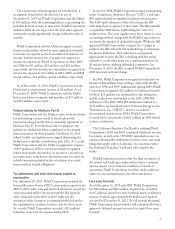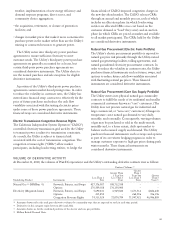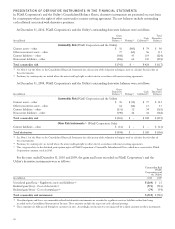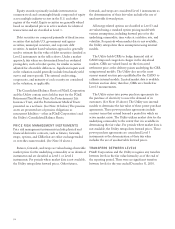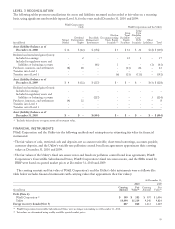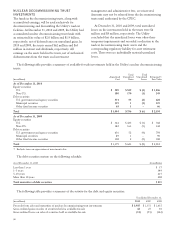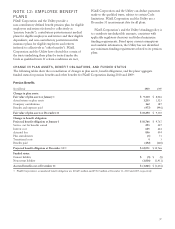PG&E 2010 Annual Report Download - page 92
Download and view the complete annual report
Please find page 92 of the 2010 PG&E annual report below. You can navigate through the pages in the report by either clicking on the pages listed below, or by using the keyword search tool below to find specific information within the annual report.The Tax Relief, Unemployment Insurance
Reauthorization, and Job Creation Act of 2010 (the “Tax
Relief Act”) Federal legislation that was signed into law on
December 17, 2010, provides for full expensing of qualified
property, plant, and equipment placed in service from
September 9, 2010 to December 31, 2011 for tax purposes.
The Tax Relief Act increased PG&E Corporation’s federal
net operating loss carry forwards. As of December 31, 2010,
PG&E Corporation has approximately $540 million of
federal net operating loss carry forwards and $45 million of
tax credit carry forwards, which will expire between 2029
and 2030. In addition, PG&E Corporation has
approximately $46 million of loss carry forwards related to
charitable contributions, which will expire between 2014
and 2015. PG&E Corporation believes it is more likely
than not the tax benefits associated with the federal
operating loss and tax credit can be realized within the
carry forward periods; therefore, no valuation allowance
was recognized as of December 31, 2010. The amount of
federal net operating loss carry forwards for which a tax
benefit from employee stock plans would be recorded in
additional paid-in capital was approximately $9 million as
of December 31, 2010.
NOTE 10: DERIVATIVES AND
HEDGING ACTIVITIES
USE OF DERIVATIVE INSTRUMENTS
The Utility faces market risk primarily related to electricity
and natural gas commodity prices. All of the Utility’s risk
management activities involving derivatives reduce the
volatility of commodity costs on behalf of its customers.
The CPUC allows the Utility to charge customer rates
designed to recover the Utility’s reasonable costs of
providing services, including the cost to obtain and deliver
electricity and natural gas.
The Utility uses both derivative and non-derivative
contracts in managing its customers’ exposure to
commodity-related price risk, including:
• forward contracts that commit the Utility to purchase a
commodity in the future;
• swap agreements that require payments to or from
counterparties based upon the difference between two
prices for a predetermined contractual quantity;
• option contracts that provide the Utility with the right to
buy a commodity at a predetermined price; and
• futures contracts that are exchange-traded contracts
committing the Utility to make a cash settlement at a
specified price and future date.
These instruments are not held for speculative purposes
and are subject to certain regulatory requirements.
COMMODITY-RELATED PRICE RISK
Commodity-related price risk management activities that
meet the definition of a derivative are recorded at fair value
on the Consolidated Balance Sheets. As long as the
ratemaking mechanisms discussed above remain in place
and the Utility’s risk management activities are carried out
in accordance with CPUC directives, the Utility expects to
fully recover from customers, in rates, all costs related to
commodity-related price risk-related derivative instruments.
Therefore, all unrealized gains and losses associated with
the change in fair value of these derivative instruments are
deferred and recorded within the Utility’s regulatory assets
and liabilities on the Consolidated Balance Sheets. (See
Note 3 above.) Net realized gains or losses on derivative
instruments related to price risk for commodities are
recorded in the cost of electricity or the cost of natural gas
with corresponding increases or decreases to regulatory
balancing accounts for recovery from customers.
The Utility elects the normal purchase and sale
exception for qualifying commodity-related derivative
instruments. Derivative instruments that require physical
delivery, are probable of physical delivery in quantities that
are expected to be used by the Utility over a reasonable
period in the normal course of business, and do not
contain pricing provisions unrelated to the commodity
delivered are eligible for the normal purchase and sale
exception. The fair value of instruments that are eligible for
the normal purchase and sales exception are not reflected
in the Consolidated Balance Sheets.
The following is a discussion of the Utility’s use of
derivative instruments intended to mitigate commodity-
related price risk for its customers.
ELECTRICITY PROCUREMENT
The Utility obtains electricity from a diverse mix of
resources, including third-party power purchase
agreements, amounts allocated under DWR contracts, and
its own electricity generation facilities. The amount of
electricity the Utility needs to meet the demands of
customers and that is not satisfied from the Utility’s own
generation facilities, existing purchase contracts, or DWR
contracts allocated to the Utility’s customers is subject to
change for a number of reasons, including:
• periodic expirations or terminations of existing electricity
purchase contracts, including the DWR’s contracts;
• the execution of new electricity purchase contracts;
• fluctuation in the output of hydroelectric and other
renewable power facilities owned or under contract;
• changes in the Utility’s customers’ electricity demands
due to customer and economic growth or decline,
88


